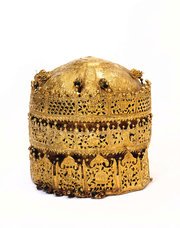U.K. Museum Offers Ethiopia Long-Term Loan of Looted Treasures
LONDON — Treasures taken by British troops 150 years ago could be returned to Ethiopia on a long-term loan from the Victoria and Albert Museum, the institution’s director said.
A crown, a chalice, a wedding dress and a selection of jewelry are among the items in the museum’s collection that are included in a new exhibition, “Maqdala 1868,” set to open Thursday.
Ahead of the exhibition, which has been organized in consultation with the Ethiopian Embassy in London to observe the 150th anniversary of the Battle of Maqdala, the director of the Victoria and Albert Museum, Tristram Hunt, told the Art Newspaper that he had made “a clear statement to the ambassador, saying that if Ethiopia is interested in pursuing the long-term loan of the Maqdala items we would stand ready to assist.”
Mr. Hunt was not available for comment. A spokeswoman for the museum said in an email, “There have already been a number discussions about further collaboration, including long-term loans of the collection.”
Continue reading the main story
The Battle of Maqdala in 1868 was a British military expedition led by Gen. Robert Napier to release British hostages held in what is now Ethiopia by Emperor Tewodros II. After British troops destroyed the emperor’s fortress, religious artifacts were ransacked; the items have since been acquired by several institutions, including the V&A and the British Museum, as well as by private collectors.
The V&A website describes the museum's collection of Ethiopian treasures as an “unsettling reminder of the imperial processes which enabled British museums to acquire the cultural assets of others.”
“This is a very well-known case where there is a serious claim for the return of cultural objects,” said Alexander Herman, assistant director of the Institute of Art and Law, an educational organization based in London. “A major British institution has at least agreed in principle to be open to some form of sharing arrangement or loan.”
Newsletter Sign Up
Continue reading the main story
Please verify you're not a robot by clicking the box.
Invalid email address. Please re-enter.
You must select a newsletter to subscribe to.
Sign Up You agree to receive occasional updates and special offers for The New York Times's products and services.
Thank you for subscribing.
An error has occurred. Please try again later.
You are already subscribed to this email.
View all New York Times newsletters.
- See Sample
- Manage Email Preferences
- Not you?
- Privacy Policy
- Opt out or contact us anytime
Ethiopia’s previous requests to the British government for the restitution of the objects have been denied. According to the Association For the Return of the Maqdala Ethiopian Treasures, only 10 of the 468 items known to have been seized at Maqdala have been returned.
Advertisement
Continue reading the main story
Around 80 of the items seized are in the British Museum’s collection. A spokeswoman for the museum said its trustees would consider a loan request by Ethiopia. She added, “There is a great public benefit to material from Ethiopia being represented within the context of the British Museum’s world collection where it is accessible to millions of international visitors a year.”
The complex issue of repatriating looted objects has rumbled on in Europe and the United States for years. President Emmanuel Macron of France said in November that the return of African artifacts was “a top priority” for his country. At a speech in Burkina Faso, he said, “African heritage can’t just be in European private collections and museums.”
Mr. Herman described Mr. Macron’s statement and the Victoria and Albert Museum’s gesture as an “important moment.” “We’re starting to see an openness on the part of at least some major Western museums to engage with communities of origin,” he said.
“The loan is a powerful method of bringing people together,” he added “It is an instrument that allows for an ongoing dialogue.”
Continue reading the main story Read the Original Article




























